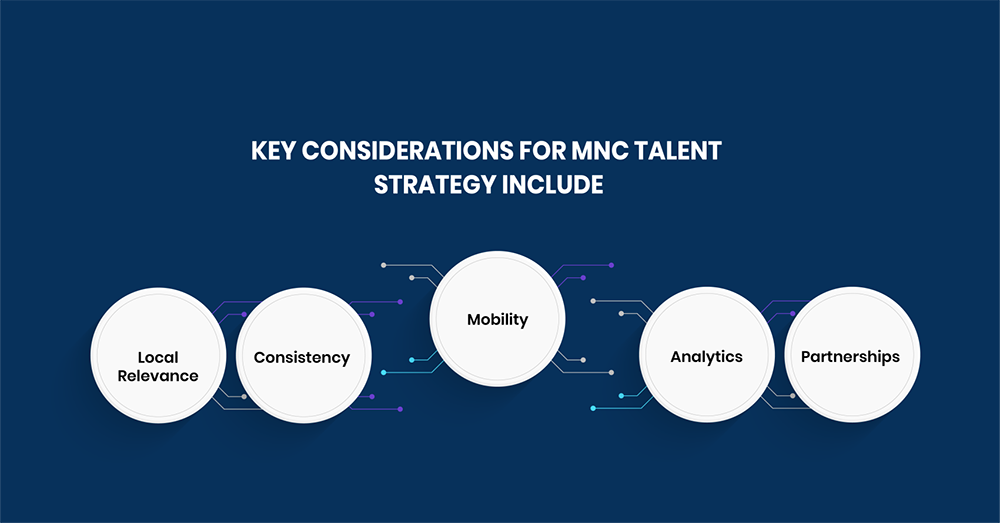
In today’s interconnected business landscape, having the right talent Strategy can determine the success or failure of multinational corporations (MNCs). However, for companies with global footprints, formulating an effective worldwide talent strategy brings unique complexities.
From aligning staffing approaches across regions to managing distributed teams, HR must balance consistency with localization when harnessing worldwide human capital. The top MNCs have crafted intricate talent playbooks to master global-local dynamics amid intensifying competition for specialized skills.
This article, decoding approaches from leading MNCs, reveals how you, too, can optimize global talent acquisition, mobility, development, and retention. With benchmarking insights from global giants in tech, manufacturing, energy, and beyond, ignite your own global talent advantage.
The expanding talent management in the USA allows worldwide sourcing but also necessitates strategies adapting to market variations. Key considerations for MNC talent strategy include:

A few companies, such as Google, exemplify the power of data-driven decision-making. Its advanced analytics and algorithmic approaches now extend to predictive hiring and employee development.
Googlers can access self-service HR platforms to visualize career roadmaps, possible rotations, and training for aspirational roles. Managers also receive AI recommendations on candidates for openings, along with insights to guide coaching.
Engineering roles use calibrated online assessments to appraise technical expertise early in the hiring workflow. This allows for recruiting massive volumes of niche digital, AI, and cloud talent with speed and objectivity.
By correlating metrics like performance scores, satisfaction trends, and retention probabilities, Google HR also continuously audits and enhances programs at scale. The emphasis remains on detecting signals revealing workforce optimization opportunities.
With its size touching 182,502 employees now, Google deploys technology for talent decisions across the employee lifecycle. Its computational people analytics unlock sharp talent visibility and decisive action across the distributed organization.
At Apple, even engineers participate in support teams to appreciate user experiences, thus aligning internal behaviors with brand values. Such an encapsulated culture fosters immense loyalty among employees despite secretive practices.
High premiums on product craftsmanship transfer into rigorous selectivity with hiring. This creates teams demonstrating almost obsessive commitment levels, working nights and weekends towards perfection before product launches.
Moreover, by limiting outsider interaction and keeping product roadmaps confidential even within, tribal culture gets reinforced. Such insulation, however, allows the unorthodox innovation that defines Apple.
Leadership development happens cross-functionally, with managers receiving exposure across technical and business roles to absorb Apple’s magic formula. Meritocracy focus ensures that high-fliers rise rapidly, with stock grants creating generational wealth possibilities.
With under 161,000 staff for a $2.73 trillion giant, Apple deliberately maintains an agile structure. Its talent strategy has innovated iconic breakthroughs for over four decades now and continues prioritizing people primordial to success.
GE deploys one of the most acclaimed corporate leadership programs globally. At its sprawling Crotonville leadership institute, thousands undergo intensive skill-building annually to drive culture and performance across divisions.
Programs build managerial and functional competencies while also accelerating high-potential development using stretch assignments, cross-divisional rotations, and external immersion. Such developmental focus has been critical for portfolio restructuring and digital transformation pivots GE has undertaken. Developing versatile leaders who can quickly reorient amid volatility underpins GE’s organizational resilience.
The company is also reimagining employment models using external talent networks. By engaging select specialists as extended teams, GE improves flexibility in accessing niche expertise. Such networks diversify capability pipelines beyond full-time staff.
With businesses spanning power, healthcare, aviation, and more, GE must nurture multifaceted leadership, finishing schools feeding its lines. Its sustained strategic edge thus stems from nurturing talent and leadership versatility.
Having earned popular employer recognition across Europe and Asia, Unilever’s talent strategy focuses on inclusive, localized excellence while optimizing global mobility.
Its Asian talent programs blend global priorities like sustainability and innovation with pertinent regional issues such as water management and green agriculture. Leadership councils regionally enhance relevance.
Development occurs experientially by exposing managers to rural markets. Immersions bring customer-centricity and community connections while accelerating market expansion. Unilever thus localizes context while aligning experiential learning to business goals.
Global roles also increasingly get staffed using local talent vs expatriates. Programme Sol predicts the success of international job transitions using analytics. Such data-driven regional mobility widens diversity.
With 400+ brands globally, Unilever must optimize talent regionally for brand resonance. Its global leadership development guidebook articulates modular principles adapted locally for relevance. This global construct has helped consistent employer equity worldwide.
The talent playbooks adopted by leading MNCs offer useful templates for emulation. While business realities differ, several underlying talent innovation principles transcend contexts:
Talent is now undisputedly central to organizational success, but the global talent management process brings additional complexity. For new global entrants struggling with scale or incumbents needing revitalization, studying multifaceted talent strategies adopted by globally dominating MNCs can bring wisdom.
Their experiences collectively offer principles to balance localization with global consistency, focus where it matters most, and tap wider spectra of partnerships externally. Developing, retaining, and deploying signature talent worldwide is the key recipe powering globally elite corporations. It is the ultimate competitive advantage no tariffs or trade wars can erode.
While still a maturing discipline, global talent management will only grow in strategic importance. Using the explorations from this piece as inspiration, may your organization also discover its own winning international talent formula!

CredBadge™ is a proprietary, secure, digital badging platform that provides for seamless authentication and verification of credentials across digital media worldwide.
CredBadge™ powered credentials ensure that professionals can showcase and verify their qualifications and credentials across all digital platforms, and at any time, across the planet.

Please enter the License Number/Unique Credential Code of the certificant. Results will be displayed if the person holds an active credential from TMI.